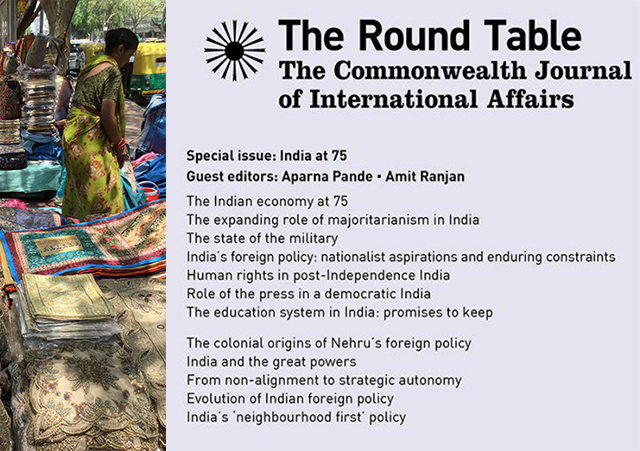 [photos: India market scene photo by Victoria Schofield and special edition journal cover]
[photos: India market scene photo by Victoria Schofield and special edition journal cover]
[This is an excerpt from an article appearing in the special edition on India at 75 of The Round Table: The Commonwealth Journal of International Affairs.]
Looking ahead at seventy-five
India’s GDP and per-capita GDP in current dollars in 2019–20 stood at $2.88 trillion and $2,140, respectively. The GDP figure makes India the fifth largest economy in the world behind the United States, China, Japan and Germany. But at just one-fifth of China in GDP and per-capita GDP terms, India has a long way to go as it travels towards its 100th birthday.
India was initially among the world’s worst impacted economies from Covid-19. On year-on-year basis, it experienced a 23.9% decline in its GDP in the April-June 2020 quarter. But it has recovered fast. The fall in GDP was limited to 7.5% in July-September quarter and, based on numerous high-frequency indicators, is reported to be back to near pre-Covid-19 level in January-March 2021 quarter. If GDP estimates confirm this inference, the overall decline in GDP in 2020–21 would be 7.5 to 8%. Unless the country is hit by a second major wave of infections, growth during 2021–22 is predicted to be in 11 to 12% range, substantially on account of a low 2020–21 base over which growth calculation will be done.
Special edition introduction: India at 75
India’s foreign policy: nationalist aspirations and enduring constraints by Ian Hall
India’s foreign policy: shift, adjustment and continuity by Amit Ranjan
Over the longer run, the central problem confronting India is that of transforming itself from a predominantly traditional, agricultural and rural structure to a modern, industrial and urban one. According to the latest Periodic Labour Force Survey (PLFS), 42.5% of India’s workforce was still employed in agriculture in 2018–19. With agriculture accounting for only 14.6% of the GDP, these figures imply that the average output per worker in agriculture is less than one-fourth of that in industry and services. Given that the average output per worker in industry and services itself is not especially impressive in view of India’s low per-capita GDP, output per worker in agriculture is truly small. The central problem India must solve is the creation of well-paid jobs in industry and services that farm workers would find sufficiently attractive to migrate to them.
Differences in average productivity per worker are greatly magnified when we consider the differences within sectors. In agriculture, 48% of the farm holdings are smaller than half hectare with the average size of these holdings being just 0.23 hectare. Such tiny holdings can scarcely help produce enough to give subsistence living to the households with five members.
The workforce in industry and services is also concentrated in tiny enterprises. According to the PLFS-2018-19, only 17.2% of the workers in industry and services report working in enterprises with 20 or more workers. A whopping 67.5% of the workers report working in enterprises with less than 20 workers. The enterprise size is not known in the case of the remaining 5.4% of industry and services workers. Enterprises with less than 20 workers exhibit very low productivity with many workers in these enterprises being self-employed at barely subsistence level of output.7
Indeed, even enterprises with 20 to 50 workers are considered small by international norms and exhibit low productivity.
Nigeria and India both face threat of terrorism
India’s place in America’s world under the Biden presidency: decoding the China factor
India–China relations – the present, the challenges and the future
India thus remains a country of tiny economic units with low per worker productivity. In large part, this problem remains imbedded in history. Decades of channelling of entrepreneurial talent into highly capital-intensive industries through licensing and other regulation combined with rigid labour laws and scarcity of urban land have hardwired Indian entrepreneurs to keep away from investing in medium and large size enterprises in labour-intensive sectors such as apparel, footwear, food processing, furniture, toys, stationery, kitchenware and numerous other light manufactures. The old pattern of capital concentrating in capital-intensive sectors and low-skilled labour remaining stuck in agriculture or SSI-type enterprises has been hard to break. In terms of output contribution, successful sectors in India have been machinery, petroleum refining, automobiles, two wheelers, auto parts, pharmaceuticals, telecommunications, and information technology. None of these sectors offered a large number of jobs for those at the low end of skill spectrum.
There is no doubt that eventually India will transform with more than half of the current workforce in agriculture migrating to industry and services. The critical question is whether it will achieve this transformation in two or four plus decades. If the country is to accomplish the speedier option, it must create an ecosystem in which many more medium and large enterprises in labour-intensive sectors emerge in a relatively short period of time. Unlike their SSI-type counterparts, medium and large enterprises have the potential to capture the vast global market and create tens of millions of well-paid jobs for limited capital investment. For instance, the global apparel market alone is worth $800 billion. But India’s exports in this sector today are less than $20 billion. Much smaller Bangladesh and Vietnam export significantly more of this product than India.
Arvind Panagariya is the Jagdish Bhagwati Professor of Indian Political Economy, Columbia University, New York.



